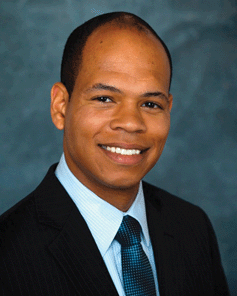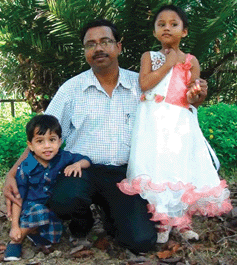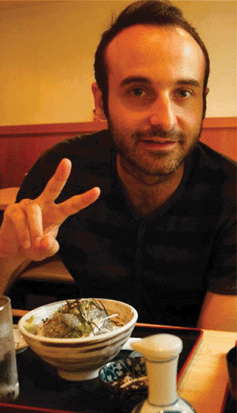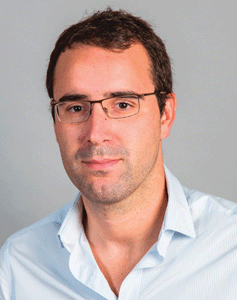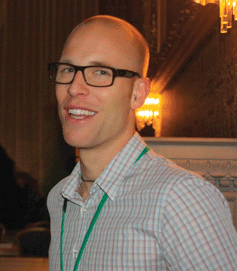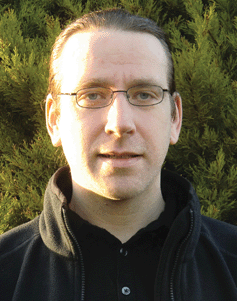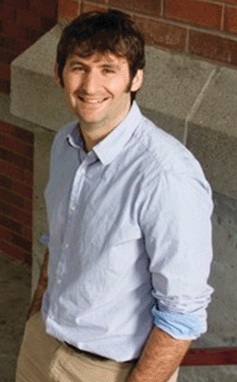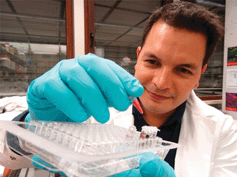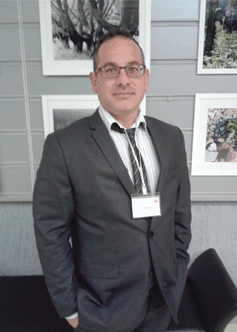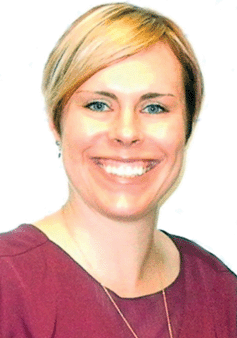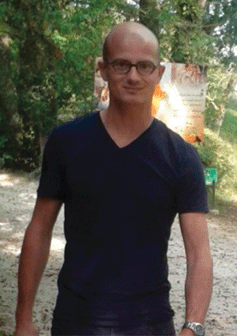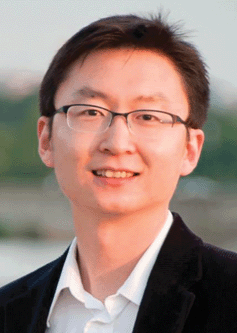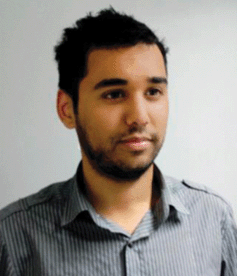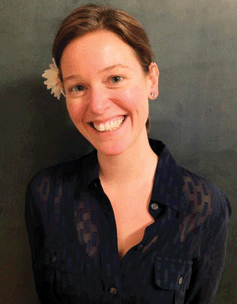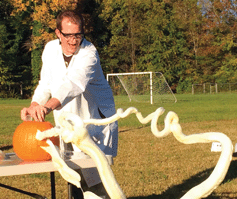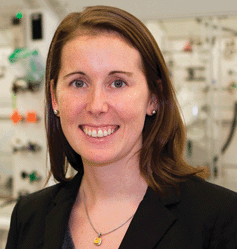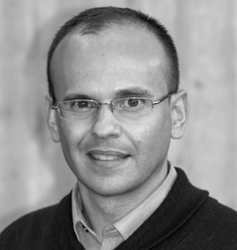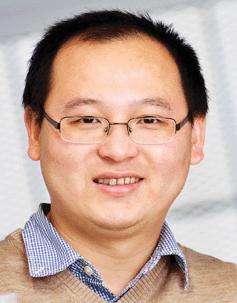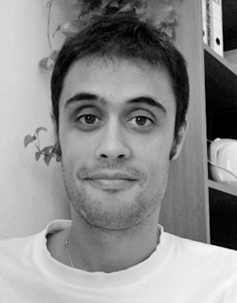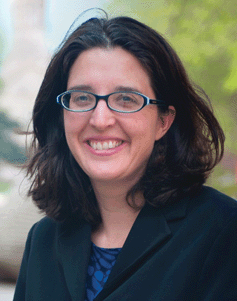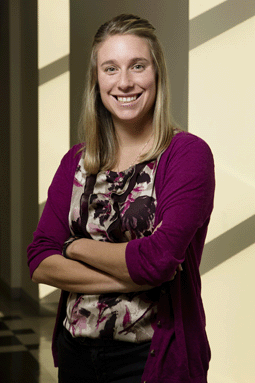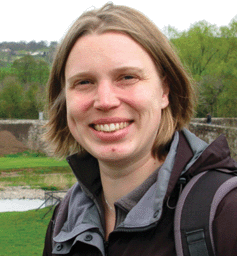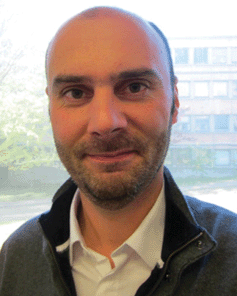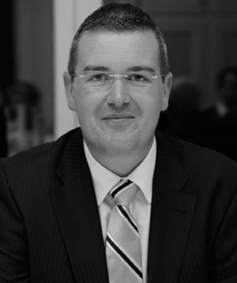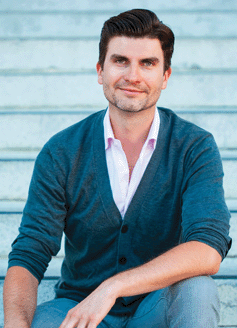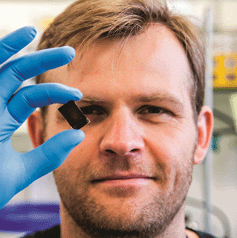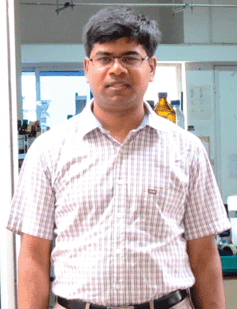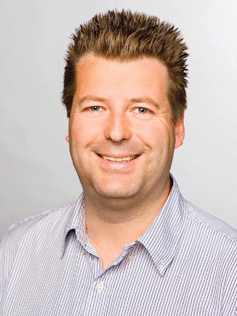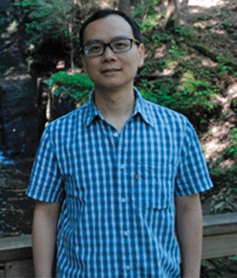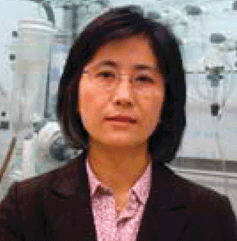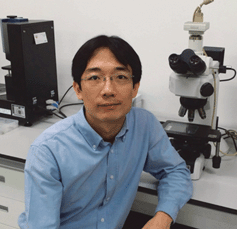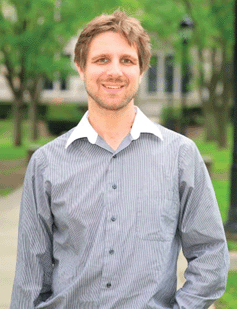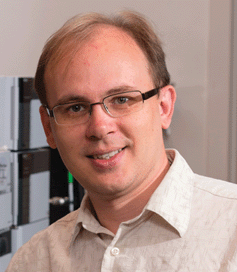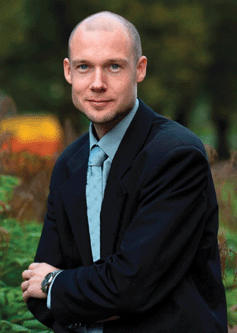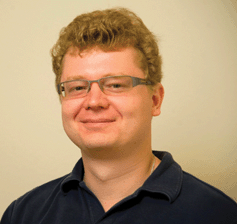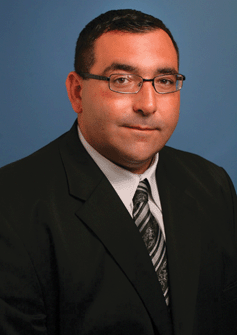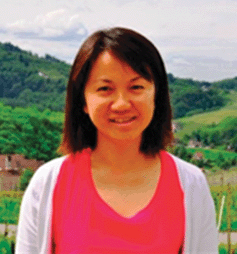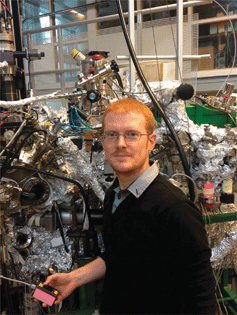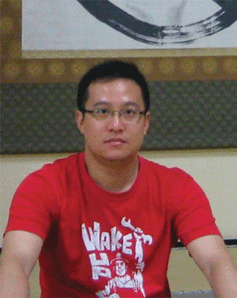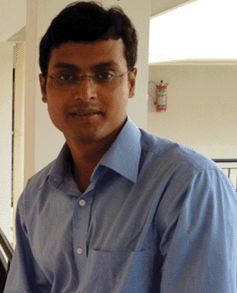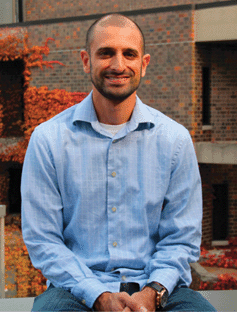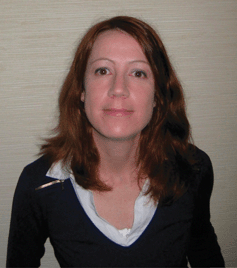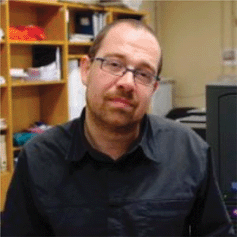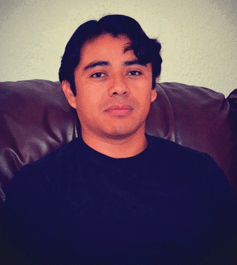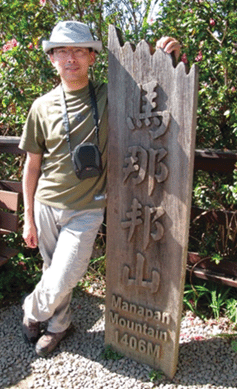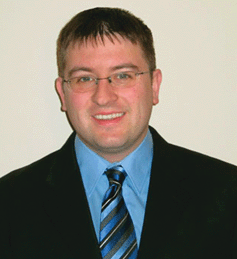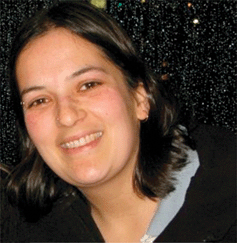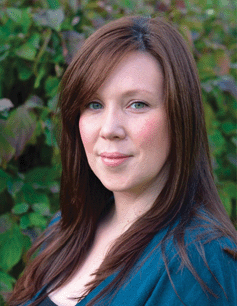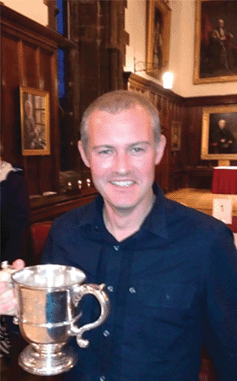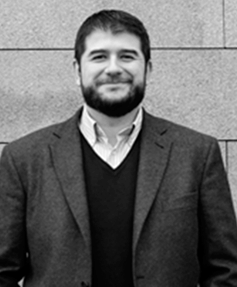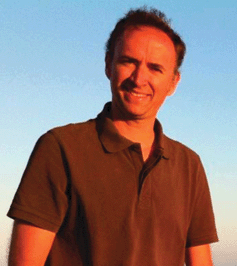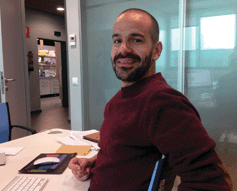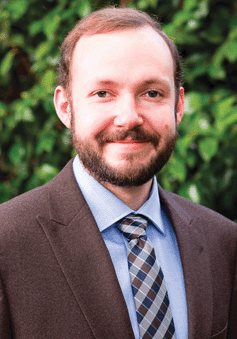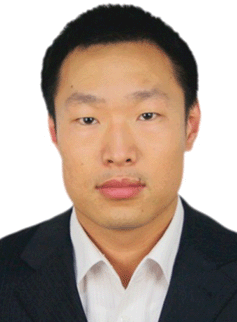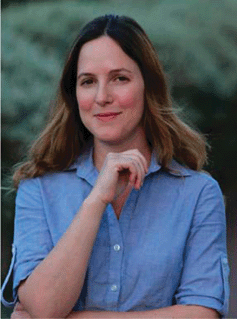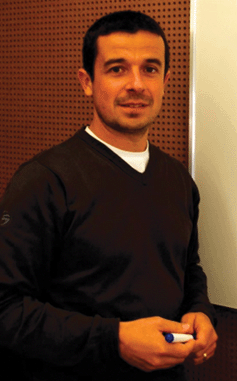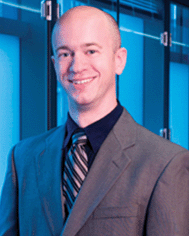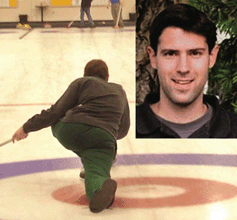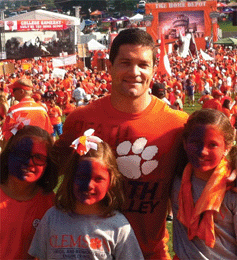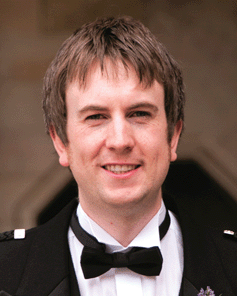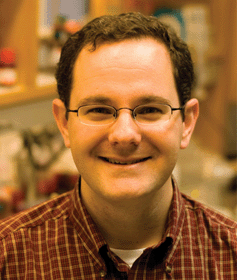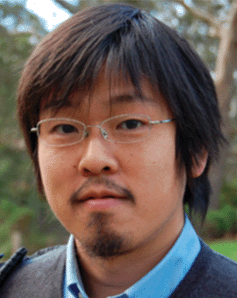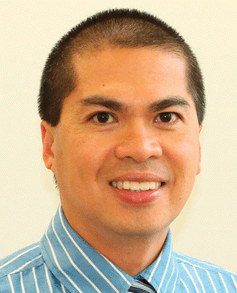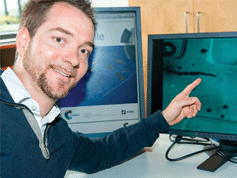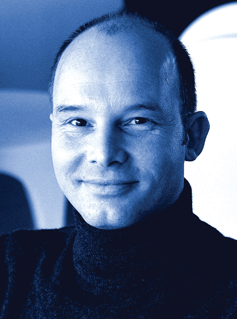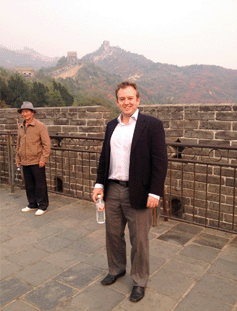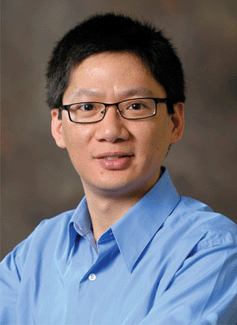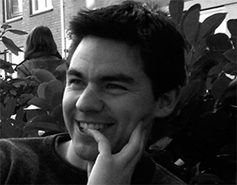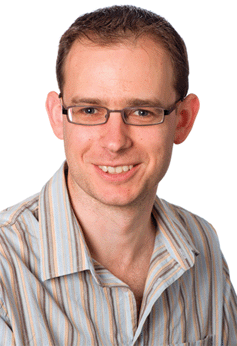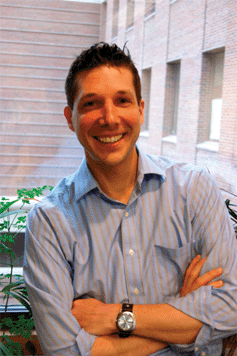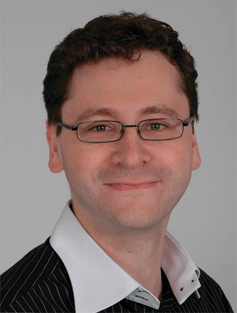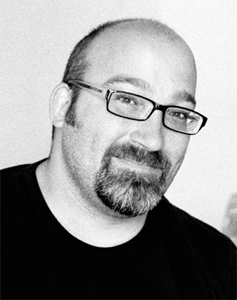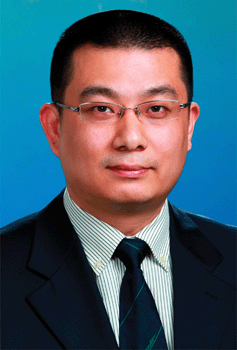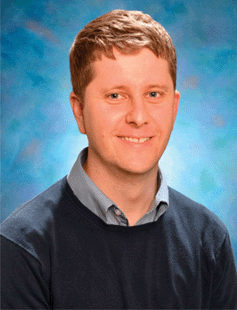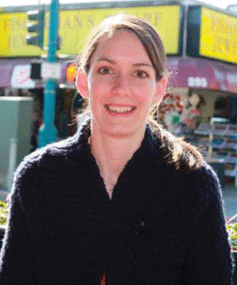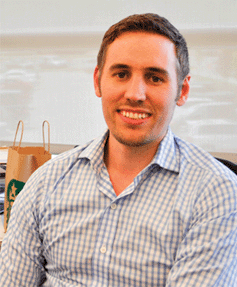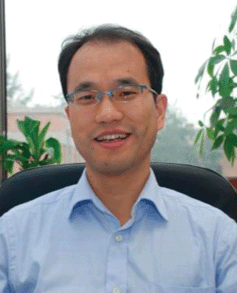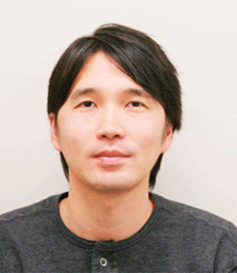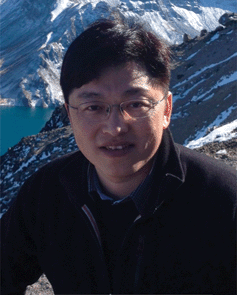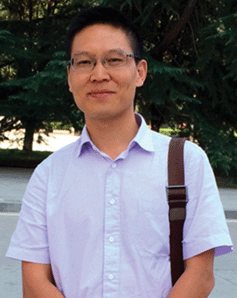DOI:
10.1039/C5CC90119G
(Profile)
Chem. Commun., 2015,
51, 5152-5169
Contributors to the Emerging Investigators Issue 2015
Randolph S. Ashton is an Assistant Professor at UW–Madison's Biomedical Engineering Department and Wisconsin Institute for Discovery. He earned his BS and PhD in chemical engineering from Hampton University and Rensselaer Polytechnic Institute, respectively, and performed postdoctoral studies at UC Berkeley. His lab melds advanced biomaterial design and neural stem cell biology to develop novel approaches for engineering ‘next-generation’ tissue models of the human central nervous system. He is the recipient of a Burroughs Wellcome Fund IRSA, was named a 2013 Rising Star by the Biomedical Engineering Society's CMBE-SIG, and his research is also funded by the NIH and EPA.
Subhendu Sekhar Bag was born at Tikarpara, Bankura, West Bengal, India and received his MSc (1st class) and PhD degrees in chemistry from IIT Kharagpur, in 1998 and 2005, respectively. After postdoctoral research (JST and JSPS) he started his independent career at the Department of Chemistry, IIT Guwahati, India, in 2008 and became an Associate Professor in 2013. He served as a Lead Guest Editor of
Journal of Nucleic Acids and is serving as an editorial board member of
Biological and Biomedical Reports,
STM Journals, and
World Research Journal of Chemistry. His research group is actively involved in designing unnatural-fluorescent nucleobase pairs which could drive the synthesis of unnatural proteins containing their designer amino acids. “Click-chemistry” is being utilized as a key step for synthesis in this research.
Pablo Barrio studied chemistry at the University of Oviedo, obtaining his PhD under the supervision of Prof. Barluenga. Later, he joined the Carreira group at ETH and then the Fustero group at the University of Valencia. He is focused on two topics: the asymmetric synthesis of benzo-fused carbo- and heterocycles and the chiral Brønsted acid catalysed allylboration reaction. He is also interested in the use of terphenyls in medicinal chemistry. In addition, he has carried out stays at Trinity College (Dublin), MPI (Muelheim) and Gakushuin University (Tokyo); part of this work was carried out at the latter.
Gonçalo Bernardes is a Royal Society University Research Fellow at the University of Cambridge. He is also the Director of the Chemical Biology and Pharmaceutical Biotechnology Unit at the Instituto de Medicina Molecular, Lisbon. After completing his DPhil degree in 2008 at the University of Oxford, UK, he then performed postdoctoral work at the Max-Planck Institute of Colloids and Interfaces, the ETH Zürich, and as a Group Leader at Alfama Inc. His research group interests focus on the development of novel site-selective protein modification chemistry and its use to provide insight into biological questions and to build modified therapeutic proteins.
Pol Besenius grew up in beautiful Northern Luxembourg. After studying chemistry at the Vienna University of Technology and the University of Strathclyde in Glasgow, he received his PhD in 2008, under the supervision of Prof. Peter Cormack and Prof. David Sherrington FRS, in collaboration with Prof. Sijbren Otto and Prof. Jeremy Sanders FRS. As a Marie-Curie Postdoctoral Fellow, Pol worked at the Eindhoven University of Technology with Dr Anja Palmans and Prof. Bert Meijer. In 2011 he set up a research group at the Organic Chemistry Institute of the University of Münster, supported by a Liebig Fellowship. Recently he has been elected as a young fellow to the North Rhine-Westphalian Academy of Sciences and Arts. His research interests include macromolecular chemistry, self-assembly in water, and supramolecular nano- and hybrid materials.
Bela E. Bode received his PhD from the Goethe University in Frankfurt am Main. In his postgraduate studies he worked on quantitative aspects of nanometre distance measurements by pulse electron paramagnetic resonance with Prof. Olav Schiemann and Prof. Thomas F. Prisner. He then joined the group of Prof. Jörg Matysik at Leiden University exploring optical methods in nuclear magnetic resonance first as a Feodor-Lynen Fellow of the Alexander von Humboldt Foundation and later as Marie-Curie Intra-European Fellow. In 2011 he moved to St Andrews to start his independent research as EaStCHEM Hirst academic fellow. Bela's research involves the methodology and applications of pulse electron paramagnetic resonance spectroscopy with a special focus on nanometre distance measurements. Outside the lab Bela loves to explore the Kingdom of Fife and the rest of Scotland.
Shannon Boettcher is currently an Assistant Professor in Chemistry at the University of Oregon. His research interests center on developing inorganic materials for solar energy conversion and storage. Boettcher received his BA in chemistry at the University of Oregon in 2003. He received his PhD in inorganic materials chemistry with Galen Stucky at UC Santa Barbara in 2008 where he was an NSF and UC Chancellor's Fellow. As a Kavli Nanoscience Institute Postdoctoral Scholar, he studied three-dimensional Si structures for solar energy conversion and storage at the California Institute of Technology working with Nate Lewis and Harry Atwater. In 2010, he returned to the University of Oregon and in 2011 was named a DuPont Young Professor and in 2014 a Cottrell Scholar.
Marcelo Calderón is an Assistant Professor for Macromolecular and Organic Chemistry at the Department of Biology, Chemistry, and Pharmacy at the Freie Universität Berlin, Germany. Dr Calderón received his PhD in organic chemistry in 2007 from the National University of Córdoba, Argentina, under the supervision of Prof. Miriam Strumia. In 2007 he joined the Research Group of Prof. Rainer Haag at the Freie Universität Berlin for his postdoctoral work, where he pursued the development of polymer-drug conjugates for the passive targeted delivery of drugs, genes, and imaging probes. Dr Calderón was the recipient of the Arthur K. Doolittle Award in 2010 (American Chemical Society, Polymer Materials: Science and Engineering Division), the Cesar Milstein Fellowship in 2011 (Ministry of Science, Technology and Productive Innovation, Argentina), and the NanoMatFutur Grant for Young Scientists from the German Ministry of Science in 2012 (BMBF).
Franck Camerel obtained his PhD from the University of Nantes in 2001 for his work on mineral complex fluids under the direction of Dr Patrick Batail and Dr Jean-Christophe Gabriel. He then moved to the Max Planck Institute of Colloids and Interfaces under the supervision of Prof. Markus Antonietti and Dr Charl Faul as a postdoctoral associate to work on the ionic self-assembly process. In 2003, he was recruited as a CNRS researcher in Dr Raymond Ziessel's group at the University of Strasbourg on the design of luminescent liquid crystals and organogelators. Since 2009, he started independent research at the University of Rennes to develop optically active metal complexes for applications in optoelectronics and biotechnologies.
Erin E. Carlson received her BA at St. Olaf College in 2000. She went on to graduate studies at the University of Wisconsin-Madison and earned a PhD in organic chemistry under the direction of Professor Laura L. Kiessling. Subsequently, Dr Carlson performed postdoctoral research at The Scripps Research Institute with Professor Benjamin F. Cravatt. Dr Carlson joined the faculty at Indiana University in 2008 and has won numerous awards, including being named a Pew Biomedical Scholar, the NIH Director's New Innovator Award, the NSF CAREER Award, the Cottrell Scholar Award and was named a Sloan Research Fellow. Her work unites tools from chemistry and biology to promote the development and application of technologies that will contribute to our understanding of new strategies for the treatment of bacterial infections and the discovery of efficacious compounds.
Vincent César (Nancy, France, 1977) studied chemistry at the Ecole Normale Supérieure in Lyon. He received his PhD from Louis Pasteur University in Strasbourg in 2004 under the guidance of Prof. Dr L. H. Gade and Dr S. Bellemin-Laponnaz. After a postdoctoral stay at the Max-Planck-Institut für Kohlenforschung with Prof. Dr A. Fürstner, Vincent was appointed as a permanent CNRS researcher at the Laboratoire de Chimie de Coordination (LCC) in Toulouse in 2006. His research interests are focused on the organometallic chemistry of N-heterocyclic carbenes in a broad sense.
Yiyun Chen (China, 1980) received his BS degree in chemistry with honors from Peking University in 2002, working with Professor Zhen Yang. After a brief stint in neuroscience research, he earned his PhD in organic chemistry from Princeton University in 2007 with Professor Chulbom Lee. Afterwards, he did postdoctoral research with Professor David R. Liu at Harvard University and Howard Hughes Medical Institute. In fall 2011, he started an independent research career at Shanghai Institute of Organic Chemistry, Chinese Academy of Sciences. His research group focuses on developing novel biocompatible opto-chemical methods to study biology.
Vijay Chudasama graduated from UCL in 2008, where he received numerous awards, including SET Chemistry Student of the Year and the Faculty of MAPS Medal. On a Research Scholarship, Dr Chudasama obtained his PhD (2011) at UCL working with Prof. Caddick, winning a collection of prizes, including the Ramsay Medal. He continued at UCL to do his postdoctoral studies and, in 2013, was highlighted by Scientific American to be one of 30 scientists across the world with excellent prospects in chemistry. In 2014, Dr Chudasama was awarded a Ramsay Fellowship and was appointed as Technical Director of a biologics company, ThioLogics™.
Brandi Cossairt graduated with a BS in chemistry from the California Institute of Technology in 2006 as a first generation college student. She completed her PhD in inorganic chemistry (2010) under the supervision of Professor Kit Cummins at the Massachusetts Institute of Technology. Following an NIH postdoctoral fellowship at Columbia University, Brandi began as an assistant professor at the University of Washington in 2012. Her group's current research interests focus on the synthetic inorganic chemistry of colloidal materials and homogeneous catalysts for sustainable technologies, including solid state lighting, thin-film photovoltaics, and small molecule activation.
Mitchell P. Croatt is an Assistant Professor in the Department of Chemistry and Biochemistry at the University of North Carolina at Greensboro. He received his BS in chemistry after doing research in the group of Professor George A. O'Doherty at the University of Minnesota in 1998. He went on to Stanford University to pursue a PhD in chemistry in the group of Professor Paul A. Wender. His postdoctoral work was conducted at the ETH-Zurich under the guidance of Professor Erick M. Carreira. Dr Croatt runs a diverse research group and enjoys iodine chemistry as seen in the photo above.
Jillian L. Dempsey started research as an undergraduate at the Massachusetts Institute of Technology where she studied with Prof. Daniel Nocera. She next headed west to pursue a PhD at the California Institute of Technology, working with Prof. Harry Gray and Dr Jay Winkler. After postdoctoral research with Prof. Daniel Gamelin at the University of Washington, she joined the faculty at the University of North Carolina in 2012. Her lab examines electron transfer processes in solar energy capture and conversion systems. In her free time, Jillian enjoys running, yoga, cooking, UNC basketball and the Sunday paper.
David Díaz Díaz received his PhD in chemistry from the University of La Laguna. In 2002, he joined Prof. Finn's group as postdoc at The Scripps Research Institute (US). Since 2006, he has held various positions in academia and industry (‘Ramón y Cajal' Researcher, UAM, Spain, 2006; Sr. Chemist, The Dow Chemical Company, Switzerland, 2007; Tenured Scientist, CSIC, Spain, 2009; Alexander von Humboldt Experienced Researcher, University of Regensburg, Germany, 2010). In 2013, he was named recipient of the prestigious
DFG Heisenberg Professorship. Among several international awards, he has received the
Young Investigator Award from the Polymer Network Group (Japan, 2014) and is Editor-in-Chief of
Gels. His main research interests focus on the development of advanced functional materials.
Xinliang Feng is a full professor at the Technical University of Dresden since 2014. He obtained his PhD degree in April 2008 at the Max Planck Institute for Polymer Research (MPIP). In December 2007, he was appointed as a group leader and later a distinguished group leader at MPIP. In 2011, he was appointed as an adjunct distinguished professor at the Shanghai Jiao Tong University and as the director for the Institute of Advanced Organic Materials. His current scientific interests include graphene, two-dimensional nanomaterials, organic conjugated materials, and carbon-rich molecules and materials for electronic and energy-related applications.
Israel Fernández (Madrid, 1977) studied chemistry at the Universidad Complutense of Madrid (UCM). In 2005, he earned his PhD (with honors) at the UCM under the supervision of Prof. Miguel A. Sierra receiving the Lilly Young Researcher Award. After that, he joined the Theoretical and Computational Chemistry group of Prof. Gernot Frenking at the Philipps Universität Marburg as a postdoctoral researcher. In 2009, he received the Young Researcher Award from the Spanish Royal Society of Chemistry and the Julián Sanz del Río award in 2011. At present, I.F. is
Profesor Contratado Doctor at the UCM. His current research includes the experimental and computational study of the bonding situations and reaction mechanisms of organic and organometallic compounds with special interest in C–C bond forming processes.
Tori Forbes received her BS in chemistry from Beloit College (Beloit, WI) and PhD in actinide chemistry and environmental mineralogy from the University of Notre Dame (Prof. Peter C. Burns). After postdoctoral research with Prof. Slavi Sevov (University of Notre Dame) and Prof. Alexandra Navrotsky (UC Davis), she began her independent career in the Department of Chemistry at the University of Iowa in 2010. Her research interests include characterizing molecular clusters for use as environmental model compounds and novel materials precursors. She is also the recipient of an NSF Career to explore the structural features that result in selective water uptake and transfer in metal organic nanotubes. When she is not in the lab, she can often be found chasing after her two kids, Alex (age 6) and Samantha (age 2).
Alison R. Fout is currently an Assistant Professor at the University of Illinois at Urbana-Champaign. She received her BS in chemistry from Gannon University. Her love for chemistry truly began while working on her MS at the University of North Carolina at Charlotte with Prof. Daniel Rabinovich. In 2009, she received her PhD from Indiana University with Prof. Daniel Mindiola where she explored the reactivity of a titanium alkylidyne and was awarded the 2010 American Chemical Society Division of Inorganic Chemistry Young Investigator Award. From 2009–2012 she was both a Mary Fieser and NIH postdoctoral Fellow at Harvard University with Prof. Theodore Betley. Alison enjoys working with her research group investigating the influences ligand design has on the reactivity of small molecules with transition metals.
Katharina Fucke: after undergraduate studies in Frankfurt/Main and registration as a pharmacist, she moved to Innsbruck and into the field of the pharmaceutical solid-state for her PhD. Following postdoctoral work with Profs J. W. Steed and J. A. K. Howard CBE FRS in Durham and T. B. Marder in Würzburg, she joined the Durham University School of Medicine, Pharmacy and Health as a Lecturer in Pharmaceutics in 2014. Her research interests lie in the formation of different crystal forms of small organic molecules and the influences leading to polymorphism as well as the stability of these crystal forms and their manufacturability.
Vincent Gandon obtained his PhD with Prof. Jan Szymoniak at the University of Reims. After a postdoctoral stay at UC-Riverside in the group of Prof. Guy Bertrand, he was appointed assistant professor at the University Pierre et Marie Curie in Paris in 2003 (laboratory of Prof. Max Malacria). In 2009, he became full Professor at the University of Paris-Sud and in 2012, he was elected junior member of the
Institut Universitaire de France. His research interests are focused on homogeneous catalysis. When not working on synthetic methodology and reaction mechanisms, Vincent uses his handyman skills to restore old houses.
Ryan Gilmour (b. 1980) was born in Ayrshire, Scotland and educated at the universities of St Andrews and Cambridge (PhD with Prof. A. B. Holmes FRS). After postdoctoral stays at the Max-Planck-Institut für Kohlenforschung (Prof. A. Fürstner) and the ETH Zürich (Prof. P. H. Seeberger) he was awarded the Alfred Werner Assistant Professorship. Between 2008 and 2015 he was an assistant professor of organic chemistry at the ETH Zürich. Since 2013 he has held the CiM Excellence Cluster Professorship of organic chemistry and chemical biology at the Westfälische Wilhelms-Universität Münster.
Kamil Godula is an Assistant Professor of Chemistry at UC San Diego. Born and raised in the Czech Republic, he earned his MSc in organic chemistry with William A. Donaldson at Marquette University and his PhD with Dalibor Sames at Columbia University in the area of C–H bond activation. He trained as a postdoctoral fellow with Carolyn Bertozzi at UC Berkeley in bio-nanomaterials and chemical glycobiology. Since 2013, he has led his own research lab at UCSD focused on developing chemical approaches to study the role of cell-surface glycans in host–pathogen interactions and to harness the regulatory functions of glycans to control stem cell differentiation. He is the recipient of the NIH Pathway to Independence Award.
Marek Grzelczak found his passion for chemistry while doing research as an undergraduate at Helmholtz-Zentrum Berlin (Germany). After receiving his BS at University of Adam Mickiewicz in Poznan (Poland), he pursued doctoral studies with Professor Luis M. Liz-Marzan at the University of Vigo (Spain), where he received his PhD in 2008. He then conducted postdoctoral research at the University of Trieste (Italy) with Professor Maurizio Prato and later at the Max-Planck Institut with Professor Markus Antonietti. In 2012 he joined CIC BiomaGUNE in San Sebastian as an Ikerbasque Research Fellow. His work at CIC BiomaGUNE focuses on the self-assembly of particles for plasmonic nanochemistry.
T. Govindaraju is an Associate Professor at the Bioorganic Chemistry Laboratory, New Chemistry Unit, JNCASR, Bangalore, India. He received his MSc in chemistry (2000) from Bangalore University and PhD in chemistry (2005) from the National Chemical Laboratory (degree awarded by the University of Pune), India. He carried out postdoctoral work (2005–2006) at the University of Wisconsin-Madison, USA. He received the Alexander von Humboldt postdoctoral fellowship and worked (2006–2008) in the Max Planck Institute of Molecular Physiology, Dortmund, Germany. His research interests are at the interface of chemistry, biology and biomimetic materials, include organic synthesis, peptide chemistry, neurodegenerative diseases (Alzheimer's disease, Parkinson's disease and type 2 diabetes), nucleic acid chemistry, molecular probes for biological applications, biomimetics and nanobiotechnology.
Tobias A. M. Gulder studied chemistry in Würzburg, where he also finished his PhD on natural product analytics and synthesis with Prof. Bringmann in 2008, followed by DAAD-funded postdoctoral research on marine natural product biosynthesis with Prof. Moore at the Scripps Institution of Oceanography (La Jolla, USA) until 2010. After his return to Germany he started his independent career in Bonn in 2011, supported by a Liebig Fellowship of the FCI and an Emmy-Noether Fellowship of the DFG. In 2014 he accepted an appointment as W2 Professor in Biosystems Chemistry at TU München. He is interested in the structure and (bio)synthesis of microbial metabolites.
Haidong Huang is an assistant professor at the New Jersey Institute of Technology (NJIT). He received his BS degree from Peking University in 2000. He then undertook PhD research projects in the area of host–guest chemistry under the direction of Dale Drueckhammer at Stony Brook University, where he received his PhD degree in 2006. Before he joined NJIT in 2009, he was a postdoctoral fellow in Marc Greenberg's research group at Johns Hopkins University. His current research interests include the molecular recognition of nucleic acid receptors and the polymerase replication of DNA alkylation damage.
Xinqiao Jia is an Associate Professor in the Department of Materials Science and Engineering at the University of Delaware. She received her PhD in polymer science and engineering from the University of Massachusetts Amherst in 2002 and conducted her postdoctoral training at MIT prior to joining the University of Delaware in 2005. Her group is developing synthetic matrices using diverse and modular building blocks employing orthogonal chemistries in conjunction with concerted supramolecular interactions. The synthetic matrices provide biomimetic environments for the engineering of functional tissues.
Sung Min Kang obtained his bachelor degree in chemistry from KAIST (Republic of Korea). He received his PhD in 2009 from KAIST after working with Prof. I. S. Choi. After postdoctoral research with Prof. H. Lee (KAIST) from 2009 to 2011, he continued his research as a research assistant professor (KAIST) from 2011 to 2012. In September 2012, he was appointed to the faculty of the Pukyong National University (PKNU, Republic of Korea). His current research focuses on developing functional surfaces inspired by living organisms.
Dominik Konkolewicz earned his Bachelors with honors in 2006, from the University of Sydney. In 2011, he earned his PhD from the same institution, advised by Prof. Sébastien Perrier, focusing on the synthesis and characterization of hyperbranched polymers made by RAFT. Subsequently he was a Visiting Assistant Professor at Carnegie Mellon University from 2011–2014, advised by Prof. Krzysztof Matyjaszewski, where he studied various synthetic and mechanistic aspects of ATRP. In August 2014, he joined Miami University as an Assistant Professor of Organic Chemistry. He focuses on the design and synthesis of useful bioconjugates and functional materials through RAFT and ATRP.
Ivan V. Korendovych received his BS and MS degrees in inorganic chemistry from the Kyiv National Taras Shevchenko University (Kyiv, Ukraine). He received his PhD degree from Tufts University working on mechanistic aspects of oxygen activation and anion recognition in the lab of Professor Elena Rybak-Akimova in 2006. For his postdoctoral studies Dr Korendovych joined the group of Professor William DeGrado at the University of Pennsylvania. Since 2011, he has been an Assistant Professor at the Department of Chemistry at Syracuse University focusing on various aspects of protein design and engineering.
Mauri Kostiainen received his MSc degree in organic chemistry from the University of Helsinki (2005) and the subsequent PhD degree in technical physics from Helsinki University of Technology with Prof. Olli Ikkala (2008). After a two-year postdoctoral period with Profs Roeland Nolte and Jeroen Cornelissen at the Radboud University Nijmegen (the Netherlands) he moved back to Finland to start up an independent research line on biohybrid materials. In 2013 he joined the Aalto University (Finland) as an assistant professor in polymer technology. His research interests lie in biohybrid materials that combine the versatility of synthetic matter and highly controlled assembly properties of biomolecules.
Kirill Kovnir is an Assistant Professor at University of California, Davis. He was born in Kirovograd, Ukraine. He studied chemistry and received a PhD at the Lomonosov Moscow State University with Prof. A. V. Shevelkov scrutinizing inverse clathrates. Afterwards he spent time between the Max Planck Institute for Chemical Physics of Solids in Dresden, and the Fritz Haber Institute of the Max Planck Society in Berlin, exploring the potential of intermetallic compounds in heterogeneous catalysis supervised by Prof. Yu. Grin and Prof. R. Schlögl. In 2008 he moved to Florida State University where he acquired a comprehensive knowledge of the magnetism of complex solids under the guidance of Prof. M. Shatruk. Kirill's research interests are in the broad field of solid state and materials chemistry. Research in his group is focused on the synthesis of novel thermoelectric, superconducting, magnetic, and low-dimensional materials and exploring their crystal structure, chemical bonding, and physical properties. Understanding the structure–property relationship is a key to the rational design of such materials.
Vincent Lavallo joined the University of California Riverside (UCR) Chemistry Department in 2011 after three years as an NIH Postdoctoral Fellow in the group of Prof. Robert Grubbs at the California Institute of Technology. He obtained his PhD degree in less than three years under the supervision of Prof. Guy Bertrand at UCR. The Lavallo research group is interested in utilizing the unique properties of icosahedral carborane anions in ligand and catalyst design. In addition, we are exploring the implementation of carborane anion derivatives as electrolytes for the development of high capacity non-Li energy storage devices.
Xing Yi Ling obtained her PhD degree from the University of Twente, Netherlands in October 2008 under the supervision of Prof. David Reinhoudt and Prof. Jurriaan Huskens. She was awarded the 2009 IUPAC Young Chemist award for her PhD research. In May 2009, she joined Prof. Peidong Yang at the University of California, Berkeley for postdoctoral research under the Rubicon fellowship from the Netherlands Organization for Scientific Research (NWO, NL). Xing Yi Ling joined the Chemistry and Biological Chemistry division at Nanyang Technological University in July 2011. In January 2012, she was awarded the Singapore National Research Foundation fellowship. Her research group focuses on fabricating surface-enhanced Raman scattering platforms by nanofabrication or shape controlled noble metals for sensing and anti-counterfeiting applications.
Kevin Lovelock obtained an MSci in chemistry at the University of Nottingham (2004). He gained his PhD with Prof. Robert Jones at the University of Nottingham (2008), and carried out postdoctoral research with Prof. H.-P. Steinrück, Dr Darren Walsh, Prof. Peter Licence and Dr Susan Perkin. In 2012 he took up an Imperial College London Junior Research Fellowship. His current research interests are studying ions in solution and at interfaces for energy applications using both laboratory and synchrotron X-ray spectroscopy.
Wei Lu has been an Associate Professor at South University of Science and Technology of China (SUSTC) since 2011. He received his BSc in 1995 at Sichuan University, his MSc in 1998 at Chengdu Institute of Organic Chemistry, CAS, and his PhD in 2003 with Prof. Chi-Ming Che at the University of Hong Kong (HKU). Before joining SUSTC, he was a Postdoctoral Researcher with Prof. Jackie K. Barton at Caltech and then a Research Assistant Professor at HKU. His current research is focused on smart supramolecular soft matter derived from small metal–organic complexes.
Debabrata Maiti received his PhD from Johns Hopkins University (USA) in 2008 under the supervision of Prof. Kenneth D. Karlin. After postdoctoral studies at the Massachusetts Institute of Technology (MIT) with Prof. Stephen L. Buchwald (2008–2010), he joined the department of chemistry of IIT Bombay as an assistant professor in 2011. His research interests are focused on the development of new and sustainable synthetic methodologies.
Neal Mankad was an undergraduate student at MIT (2000–2004, research advisor: Joseph Sadighi), a PhD student at Caltech (2010, advisor: Jonas Peters), and a NIH postdoctoral research fellow at the University of California, Berkeley (2010–2012, advisor: Dean Toste). In 2012, Neal began his independent academic career at the University of Illinois at Chicago, where his group studies synthetic inorganic chemistry, organometallic chemistry, and homogeneous catalysis. Neal is an avid fan of sports and live music and enjoys the dining options provided by living in downtown Chicago.
Géraldine Masson received her PhD in 2003 from the Joseph Fourier University, France, under the supervision of Dr Sandrine Py and Professor Yannick Vallée. In 2005, she moved to the University of Amsterdam as a Marie Curie postdoctoral research fellow where she worked with Professors Jan van Maarseveen and Henk Hiemstra. In 2005, she joined Professor Jieping Zhu's research group at the Institute for the chemistry of natural substances (ICSN) as a CNRS researcher, before starting her independent career in 2010. She was promoted to Director of research in 2014. Géraldine has been awarded the Diverchim Prize (Prize for Innovation, 2011) and the CNRS bronze medal (2013). Her research interests include development of new organocatalytic enantioselective reactions, novel synthetic methodologies, and photoredox catalysis, as well as their applications in syntheses of diverse natural and non-natural molecules displaying biological activities.
Manuel Melle-Franco was born in Spain in 1972. He graduated in chemistry in 1996 at Santiago of Compostela University, Spain, obtained a MSc in materials and a PhD in physics at the University of Kent, UK, with A. V. Chadwick, on ionic materials (2001). After that, he joined Francesco Zerbetto at the University of Bologna, Italy, working on carbon nanomaterials. In 2011 he joined the University of Minho, Portugal, as an independent researcher. Manuel currently develops and uses computer models for the physics, chemistry and molecular biology of nanomaterials, but also works in HPC, polymer engineering, pharmacy and biomaterials.
Gabriel Merino was born in Puebla (México) in 1975. He received his PhD from Cinvestav in 2003. After a two-year period as Postdoctoral Associate at Technische Universität Dresden, Gabriel started his independent career at Universidad de Guanajuato. In 2012, he joined the Department of Applied Physics at Cinvestav Mérida. His group is focused on predicting molecular systems that violate what is established by traditional chemistry and that allow taking to the limit basic concepts like structure, chemical bond, and aromaticity. He has co-authored 100 articles and was awarded the 2012 Academia Mexicana de Ciencias and the Moshinsky Foundation Awards.
Kwok-Kong Tony Mong was born in Hong Kong and obtained his PhD (2000) in organic chemistry with Professor Hak Fun Chow at the Chinese University of Hong Kong. He was the recipient of the Croucher Fellowship in 2000 and joined Professor Chi-Huey Wong as a postdoctoral fellow. Tony started his independent career in 2005 at the National Chiao Tung University, Taiwan and was promoted to Associate Professor in 2010. Current research focuses include developing new synthetic methods, synthesis of atypical carbohydrate molecules, oligosaccharide synthesis, and glycosylated natural products. Outside laboratory, Tony enjoys tennis and mountain hiking.
Pavel Nagorny received his BS degree in chemistry in 2001 from Oregon State University where he conducted research in the laboratory of Professor James D. White. After earning his PhD degree in chemistry under the mentorship of Professor David A. Evans from Harvard University in 2007, he spent three years as a postdoctoral fellow with Professor Samuel J. Danishefsky at the Memorial Sloan-Kettering Cancer Center. In 2010, Pavel joined the faculty of the University of Michigan. Currently, Pavel is William R. Roush Assistant Professor in chemistry.
Louise Natrajan is a Reader in Chemistry at the University of Manchester. She studied at the University of York (UK) and received her PhD from the University of Nottingham (UK) with Professor Polly Arnold. She then moved to the CEA, Grenoble, France as a PDRA with Dr Marinella Mazzanti and then moved back to the UK as a PDRA with Professor Stephen Faulkner at the University of Manchester. In 2008, she was awarded an EPSRC Career Acceleration Fellowship and in 2012 a Leverhulme Trust Research Leadership award. Her current research focuses on the coordination chemistry and optical properties of f-elements.
Rebecca Notman is a Royal Society University Research Fellow in the Department of Chemistry at the University of Warwick (2012-present). Her research expertise is in molecular simulation, applied to a range of problems in healthcare, pharmaceutics and bionanotechnology. From 2009–2012, Rebecca held an independent Science City Research Fellowship, also at Warwick, with an honorary position in the Department of Mathematics at the University of Birmingham. Prior to this she held a PDRA position in biomaterials modelling (Warwick, 2007–2009) and achieved her PhD in computational pharmaceutical science (King's College London, 2003–2007).
Anthony O'Mullane is an Australian Research Council Future Fellow and Senior Lecturer at Queensland University of Technology (Australia). He received his PhD degree (2001) from University College Cork (Ireland) and completed postdoctoral fellowships at Technische Universitat Darmstadt (Germany), the University of Warwick (UK), and Monash University (Australia). He previously held a position (2008) at RMIT University (Australia) until moving to QUT in 2013. He is currently Chair of the Electrochemistry Division of the Royal Australian Chemical Institute. He enjoys investigating the electrochemical synthesis and characterisation of nanostructured materials, (electro-) catalysis, Li batteries, and applying electrochemical methods to various aspects of physical, chemical and biological science. Outside of academia he spends as much time as he can with his wife and 2 daughters, keeping fit and indulging in any sporting activity that is centred around the use of a ball of any size or shape.
Emanuele Orgiu is Assistant Professor at the Faculty of Chemistry as well as a research scientist at Institut de Science et d'Ingénierie Supramoléculaires (ISIS) at the University of Strasbourg. He holds a PhD in the physics of organic devices, earned in 2008 from the University of Cagliari (Italy) working under the supervision of Prof. A. Bonfiglio. He was the recipient of a J. W. Fulbright Fellowship from the University of Santa Clara, Santa Clara, CA, in 2007, for fostering entrepreneurship in young researchers. In 2013, he was awarded the Technology Review Award–MIT Under35 for France. He is the coordinator of the European project “UPGRADE” (bottom-UP blueprinting GRAphene baseD Electronics). He works in the fields of materials science and physics, with a focus on interfaces and transport in both graphene and organic semiconductors, and the fabrication and characterization of nanodevices.
Diego Peña Gil was born in Santiago de Compostela, the final destination of a famous pilgrim's path in northwestern Spain. He obtained his PhD degree in 2001 from the University of Santiago de Compostela. During 2002 and 2003 he joined the group of Ben L. Feringa (Groningen University, The Netherlands) as a Marie Curie Post-Doctoral Fellow working on asymmetric catalysis. In 2004 he moved back to the University of Santiago de Compostela where he is Associate Professor. His main research interests are focused on the development of new synthetic methodologies, the chemistry of arynes, and the synthesis of large aromatic compounds and nanographenes. Beyond science, he loves to spend time and relax with his three children, family and friends.
Emilio M. Pérez obtained his BSc (2000) and MSc (2001) from the Universidad de Salamanca. He then joined the group of Prof. David A. Leigh at the University of Edinburgh, where he obtained his PhD in 2005. After a postdoctoral stay with Prof. Nazario Martín at the Universidad Complutense de Madrid, he joined IMDEA Nanoscience as a Ramón y Cajal researcher in December 2008, where he is currently a Senior Researcher. In 2011–2012 he received support from an ERC Starting Independent Research Grant to establish his own research group at IMDEA. His main research interests concern the development of novel methods for the chemical modification of low-dimensional materials, supramolecular chemistry, molecular recognition, self-assembly, and the construction of molecular machinery. He is a member of the Young Academy of Europe, and has received several awards, including the 2006 IUPAC Prize for Young Chemists, the 2010 UCM Foundation Prize for Science and Technology, and the 2013 Ramón Catalán Prize for Scientists < 40 y.o.
Michael Pluth is an Assistant Professor of Chemistry at the University of Oregon. He earned his PhD in 2008 under the joint direction of Robert G. Bergman and Kenneth N. Raymond at UC Berkeley, where he investigated supramolecular chemistry and catalysis. He then moved to MIT, where he was an NIH Pathway to Independence Postdoctoral Fellow with Stephen J. Lippard and investigated methods for biological nitric oxide detection. In 2011, he began his independent career at the University of Oregon. His research interests are thematically based on different aspects of molecular recognition at the interface of bioorganic and bioinorganic chemistry.
Da-Hui Qu was born in China in 1980. He obtained his BS degree from Qingdao University in 2000 and received his PhD degree in applied chemistry in 2006 from East China University of Science and Technology (ECUST) under the supervision of Prof. He Tian. From July 2006 to Jan 2009, he worked with Prof. Ben L. Feringa as a postdoctoral fellow at the University of Groningen. Since 2009, he has worked at ECUST and now he is a full professor at ECUST. His current research focuses on controllable supramolecular polymers and molecular-level devices and machines with adjustable optical properties.
Meital Reches is a senior lecturer at the Institute of Chemistry, the Hebrew University of Jerusalem. She received her PhD (
with distinction) in 2007 from Tel Aviv University. In 2007–2010, she was an EMBO and a HFSP postdoctoral research fellow at Harvard University. Meital Reches joined the Institute of Chemistry of the Hebrew University of Jerusalem as a faculty member in October 2010. Her research focuses on developing new biomolecular self-assembled systems and the study of peptides interactions with inorganic surfaces. During her academic career she has been awarded with the Allon fellowship for young faculty members and the Teva Prize.
Olivier Renaudet received his PhD in 2002 in the field of peptide and carbohydrate chemistry in the group of Prof. P. Dumy at the Université Joseph Fourier, Grenoble (France). Thereafter, he pursued postdoctoral research in the group of Prof. J.-L. Reymond at the University of Berne (Switzerland), then he returned to Grenoble to obtain an Assistant Professor (2004) and a full Professor position (2012) at the Department of Molecular Chemistry. He was awarded junior member at the Institut Universitaire de France in 2011 and an ERC Consolidator Grant in 2014. His current research activities focus on the synthesis of polyfunctional homo- and heteroglycoclusters as antitumoral synthetic vaccines, nanovectors or anti-pathogenic agents.
Robert Riggleman is an Assistant Professor in Chemical and Biomolecular Engineering at the University of Pennsylvania. Robert received his BS from the University of South Carolina-Columbia before moving to the University of Wisconsin-Madison to obtain his PhD in 2007 under the supervision of Juan de Pablo and Paul Nealey. He stayed on as a postdoc with Prof. de Pablo through 2008 before joining Glenn Fredrickson's group as a postdoc at the University of California-Santa Barbara and then joined the faculty at the University of Pennsylvania in 2010. Robert's research group studies the mechanical properties of materials and develops novel simulation techniques to study self assembly in polymer nanocomposites.
Eric Rivard completed his BSc (Honors) at the University of New Brunswick and PhD at the University of Toronto under the supervision of Professor Ian Manners. After NSERC-sponsored postdoctoral work with Professors Jonas Peters and Philip Power, and research with Professor Cameron Jones, he joined the University of Alberta in 2008 where he is currently an Associate Professor. He has received multiple research and undergraduate teaching awards and has published over 60 papers thus far. When he is not exploring molecular main group and polymer chemistry he can be found on the curling ice/sheet “throwing some stones”.
Mark Roberts joined Clemson University's Chemical and Biomolecular Engineering Department in 2010, where he studies polymeric and carbon nanomaterials for high-energy supercapacitors and temperature-responsive electrolytes with switchable properties for thermal stability in Li-ion batteries. Roberts received his BS at Montana State University (2002) and his MS and PhD at Stanford University (2009), all in chemical engineering. His PhD work, advised by Prof. Zhenan Bao, focused on organic dielectric and semiconductor materials for chemical and bio-sensors. Prior to Clemson, he worked as a postdoc at Sandia National Labs studying functional polymers for various energy applications. In addition to academics, Roberts values faith, family and friends.
Stuart D. Robertson comes originally from Falkland, Fife and made the short trip to St Andrews where he received MChem (2002) and PhD degrees (2006), the latter in the group of Derek Woollins. Following this, he moved to the University of Calgary to carry out postdoctoral research under the mentorship of Tris Chivers. In 2009 he returned to his native Scotland to join the group of Robert Mulvey at the University of Strathclyde where he commenced an independent research program in 2012 thanks to a Royal Society of Edinburgh BP Trust Fellowship. Current research interests involve the practical applications of homo- and heterometallic molecular systems, particularly those involving alkali-metals and environmentally benign, inexpensive metals such as aluminium.
Jonathan G. Rudick is an assistant professor of chemistry at Stony Brook University. He received his undergraduate training at Case Western Reserve University (BS, 2000). Following his graduate research (PhD, 2005) with Virgil Percec in the Department of Chemistry at the University of Pennsylvania, he spent a short period as a scientist with Procter & Gamble (Cincinnati, OH). From 2007–2010, he was an NIH Postdoctoral Fellow with William F. DeGrado at the University of Pennsylvania. Jon's research program focuses on the chemical synthesis of precisely defined macromolecules and explores opportunities for these new materials in supramolecular chemistry.
Kei Saito is currently a principal investigator and a Lecturer at the School of Chemistry, Faculty of Science, Monash University, Australia. He received his BEng (2000), MEng (2002) and PhD (2004) degrees from Waseda University, Tokyo, Japan. From 2004–2005, he was a Research Associate at the 21COE Centre for Practical Nano-Chemistry, Department of Applied Chemistry, Waseda University, Japan. From 2005–2007, he was a postdoctoral fellow at the Centre for Green Chemistry, University of Massachusetts Lowell, USA. His research interests are in developing new sustainable/environmentally benign synthesis and production methods for novel organic and polymeric materials.
Jonel Saludes is an Assistant Professor at Washington State University. He earned a BSc in chemistry at the University of San Agustin (Iloilo City, Philippines), a PhD in organic chemistry at UC Davis (Prof. Jacquelyn Gervay-Hague), and a postdoctoral fellowship in chemical biology at CU Boulder (Prof. Hubert Yin). His research focuses on the structure-guided design of membrane-permeable peptides that function as intracellular delivery agents of anticancer and antimicrobial compounds. His nonscientific interests include hiking, running, and road biking. He is an active supporter of American Diabetes Association's Tour de Cure and rode the foothills of Rocky Mountains to help raise funds for this cause.
Samuel Sánchez is a chemist who specialized in electrochemical nano-bio-sensors during his PhD (Autonomous University of Barcelona, 2008). From Assistant Professor in Spain, he moved to Japan with a tenure-track ICYS-MANA position at the National Institute for Materials Science. In May 2010 he moved to the Institute for Integrative Nanoscience at the IFW Dresden to lead the “Biochemical Nanomembranes” group. Since September 2013, he has been leading the “Smart Nano-Bio-Systems” research group at the Max Planck Institute for Intelligent Systems and since January 2015 he has also been ICREA Professor at the Institute of Bioengineering of Catalonia. He received several awards for his work: the Guinness World Record® for “The smallest man-made jet engine” in 2010, the ERC-Starting Grant 2012, and the MIT Technology Review award TR35 Spain “Innovator of the year 2014”, among others.
Thomas Schafer earned his BSc from the Friedrich-Alexander University Erlangen-Nürnberg and MSc in chemical engineering from the Technical University Hamburg-Harburg (Germany). He has worked as a postgraduate researcher at Wageningen University (The Netherlands) and the University of New South Wales (Sydney, Australia), and after his PhD from Universidade Nova de Lisboa (Portugal) as postdoctoral researcher at Università degli Studi di Siena, Università di Pisa (Italy), as well as Universitat Rovira I Virgili (Tarragona, Spain). Since 2009, he has finally settled as Ikerbasque Research Professor at POLYMAT, University of the Basque Country (Spain), leading a multi-disciplinary group in nanobiotechnology.
Dwight Seferos is a Seattle Washington native and attended Western Washington University, completing a BS degree in 2001. He entered the graduate school at the University of California, Santa Barbara where he worked under the supervision of Guillermo Bazan on the synthesis and study of organic molecules with delocalized pi-electron systems. After completing a PhD in 2006, Seferos moved to Northwestern University where he was an American Cancer Society Postdoctoral Fellow with Chad Mirkin. In 2009, Seferos began his independent laboratory at the University of Toronto where he and his highly talented team of students and postdoctoral fellows study the optical and electronic properties of semiconducting polymers and nanomaterials. He has authored or coauthored over 60 publications and has more than 10 patents and patent applications. Since beginning his independent career he has been recognized with a DuPont Young Professor Grant (2011), Ontario Early Research Award (2011), Canada Research Chair (2012), and Alfred P. Sloan Research Fellowship (2013).
Qilong Shen was born in 1974 in China. Nanjing University (BSc 1996), Shanghai Institute of Organic Chemsitry (MSc 1999 with Prof. Long Lu), University of Massachusetts at Dartmouth (MSc 2002 with Prof. Gerald B. Hammond), Yale University (PhD 2007 with Prof. John F. Hartwig), UIUC (postdoc, 2007–2010 with Prof. Jeffrey S. Moore). In 2010, he was appointed as a full professor at Shanghai Institute of Organic Chemistry, Chinese Academy of Sciences. His research interests include transition metal catalysis and organofluorine chemistry.
Stephen Sproules obtained a PhD from the University of Melbourne, which included collaborations with the Universities of Nottingham and Saskatchewan, and the Stanford Synchrotron Radiation Laboratory. His postdoctoral work focused on combining experiment and theory to elucidate the electronic structures of transition metal complexes with radical ligands at the then Max Planck Institute for Bioinorganic Chemistry with Karl Wieghardt. This was followed by a posting at the EPSRC National EPR facility at the University of Manchester with David Collison and Eric McInnes. In 2013, he began his current position as lecturer at the University of Glasgow. Stephen's research focuses on the development of radical ligand complexes for a variety of magnetic and spintronic applications. Dithiolene ligands and EPR spectroscopy continue to feature prominently.
Christopher Sumby was born and raised in Christchurch, New Zealand and completed BSc(Hons) and PhD degrees at the University of Canterbury. He held postdoctoral and fellowship positions at the University of Leeds and the University of Otago before taking up a tenured position at the University of Adelaide in 2007, where he undertakes research into the synthesis and properties of nanomaterials. He was an Australian Research Council Future Fellow from 2010 to 2014 and has been awarded various fellowships and awards, including a South Australian Young Tall Poppy (2009) and a Japan Society for the Promotion of Science International Invitational Fellowship (2014).
Nathaniel Szymczak is the Dow Corning Assistant Professor of Chemistry at the University of Michigan. He developed a deep appreciation for secondary sphere interactions at a young age when watching a spider “bind and activate” a small, juicy morsel with assistance from auxiliary functionality. Following undergraduate work at the University of Illinois at Champaign-Urbana, he obtained his PhD with David Tyler at the University of Oregon. He travelled from the west coast to the east, and then back again for his postdoctoral work with Jonas Peters, which started at MIT and finished at Caltech. He has received the NSF CAREER award and the Alfred P. Sloan Fellowship, and since 2010, his group has been has been working to exploit secondary-sphere interactions for selective catalysis and to develop efficient hydrogenation/dehydrogenation catalysis.
Ed Tate is Professor of Chemical Biology at Imperial College London. His PhD research with Prof. Steve Ley (Cambridge, 2000) was in synthetic methodology and natural product total synthesis, and he undertook postdoctoral research as an 1851 Research Fellow in the group of Prof. Sam Zard (Ecole Polytechnique), and as a Howard Trust Fellow in the lab of Dr Annie Kolb (Institut Pasteur, Paris). He then moved to Imperial and founded a new research group in chemical biology and chemical proteomics as a BBSRC David Phillips Research Fellow; he remained at Imperial, and was appointed to a Chair in Chemical Biology in 2014. More than 40 researchers in his group are engaged in multiple aspects of chemical biology and chemical proteomics, particularly in the fields of protein modification and drug target identification/validation. Ed is a Fellow of both the Royal Society of Chemistry and the Society of Biology, and he has been awarded the Wain Medal (2012), the RSC MedImmune Protein and Peptide Science Award (2013), and the Norman Heatley Award (2014).
M. Eugenio Vázquez (1973) graduated in chemistry from the University of Santiago de Compostela in 1996, and obtained his PhD under the supervision of Prof. José L. Mascareñas, working on synthetic DNA-binding peptides. In 2001 he received the “
Human Frontier Science Program” fellowship and joined Prof. Barbara Imperiali at MIT, where he worked for three years on the development of caged compounds and fluorescent probes. He returned to Santiago as a “
Ramó
n y Cajal” researcher in 2004, and obtained a permanent position in 2010. In 2008 he received the RSEQ
Sigma-Aldrich Young Researchers Award and in 2012 the
Lilly Young Researchers Award.
Haudong Wang received his BS at Peking University in 2000 and his PhD in 2005 at Texas A&M University under the supervision of François Gabbaï. He then joined the group of Gerhard Erker at the University of Münster as an Alexander von Humboldt fellow. In 2009, he joined the Department of Chemistry at Fudan University (Shanghai, China) as an associate professor and was promoted to professor in 2015. His research interests concern the synthesis of organoboranes and their application in small-molecule activation.
Brendan Wilkinson completed his undergraduate degree and PhD at Griffith University, Brisbane, Australia, under the supervision of Associate Professor Sally-Ann Poulsen. He moved to the UK to undertake a postdoctoral position at Oxford University under the supervision of Professor Antony Fairbanks, and later at the University of Sydney with Associate Professor Richard Payne. Brendan was awarded an ARC fellowship in 2012 and was later appointed as a lecturer at Monash University. His main research areas are the supramolecular assembly of stimuli-responsive carbohydrate and glycopeptide amphiphiles, and dynamic carbohydrate macrocycles with drug delivery applications.
Charlotte E. Willans received her MChem degree from the University of York, entering the world of research during her placement year at DSM (Netherlands), working with Johannes and André de Vries. She was drawn back to York in 2002 to complete her PhD, working with Fran Kerton and Jason Lynam on lanthanide and organophosphorus chemistry. She migrated further north to Durham in 2006 to do a post-doc with Jonathan Steed, working on MOFs, anion binding and NHCs. In 2009, Charlotte was awarded a Royal Society Dorothy Hodgkin Fellowship which she took to Leeds, and now leads a talented research group working on several aspects of NHC chemistry.
Arthur Winter received his PhD in 2007 from the University of Maryland working under the direction of Dan Falvey. He then performed postdoctoral research at the Ohio State University under the mentorship of Christopher Hadad. He began his independent research career at Iowa State University in 2009, where he works on physical organic chemistry problems of relevance to biology and medicine.
Huaping Xu is an associate professor at the Department of Chemistry, Tsinghua University. He received his BS in 2001 and PhD in 2006 from Jilin University, under the supervision of Prof. Xi Zhang. During 2004–2005, he worked as an exchange student at the University of Leuven. In 2006, he joined Prof. David N. Reinhoudt and Prof. Jurriaan Huskens' group at the University of Twente as a post-doc. Since July 2008, he has worked at Tsinghua University. In 2011, he received the Young Chemists Award of the Chinese Chemical Society. In 2014, he received the National Science Fund for Distinguished Young Scholars. His current research focuses on selenium-containing polymers.
Sung Ho Yang is an assistant professor of chemistry education at Korea National University of Education. He has dreamed and tried to make a beautiful world with science since his childhood. Finally, he became a chemist by getting PhD degrees from the department of chemistry in KAIST. He applied biomimetic synthesis and thin films fabrication to biological systems, leading to encapsulation of living cells with artificial materials through chemical reactions on the interface of biological systems and aqueous medium. The concept of “life in a shell” would promote a new research field such as artificial spores and single cell biology.
Ying-Wei Yang received his degrees (BSc in 2000, PhD in 2005) from Nankai University, China. He was a postdoctoral scholar with John Chaput at ASU (2005–2006), Sir Fraser Stoddart at UCLA (2006–2008), and Zhibin Guan at UC Irvine (2008–2010). In 2011, he became an Associate Professor in the College of Chemistry at Jilin University, and then was promoted to Full Professor in 2014. He serves on the Editorial Board of
Scientific Reports and
Chinese Chemical Letters. He is currently the executive director of the International Joint Research Laboratory of Nano-Micro Architecture Chemistry (NMAC) at Jilin University. His research interests include organic supramolecular chemistry, multifunctional organic–inorganic hybrid nanomaterials, and stimuli-responsive polymers.
Shifa Zhu is a professor of chemistry at the South China University of Technology. Prof. Zhu received the bachelor degree from Hunan University in 2001. He obtained his PhD from Shanghai Institute of Organic Chemistry, Chinese Academy of Sciences (SIOC) in 2006, under the supervisor of Prof. Shizheng Zhu. After 2 years of postdoctoral training with Prof. X. Peter Zhang from 2007–2008 at the University of South Florida, he returned to China and joined South China University of Technology (SCUT) in 2009 and started his independent research. His current research interests focus on transition metal-catalyzed reactions.
|
| This journal is © The Royal Society of Chemistry 2015 |
Click here to see how this site uses Cookies. View our privacy policy here. 
